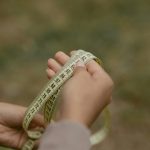Are you working with silk fabric and unsure of what needle to use? Look no further!
This article will guide you through the process, helping you understand the different types of needles available for silk fabric.
You’ll also learn how to select the right needle size and receive valuable tips for sewing silk fabric.
Don’t worry about needle maintenance – we’ve got you covered.
Get ready to sew silk like a pro!
Table of Contents
Understanding Silk Fabric
If you’re working with silk fabric, you’ll need to understand its unique properties and care requirements. Silk fabric is known for its luxurious feel and delicate nature. It is a natural protein fiber that is produced by silkworms. The properties of silk fabric make it highly desirable for clothing and other textile applications.
One of the key properties of silk fabric is its lustrous appearance. It has a natural sheen that gives it a beautiful and elegant look. Silk fabric is also known for its smooth texture, which feels soft and comfortable against the skin. It is breathable and has excellent moisture-wicking properties, making it ideal for warm weather.
Caring for silk fabric requires special attention. It is recommended to hand wash silk garments using a mild detergent and lukewarm water. Avoid using harsh chemicals or bleach, as they can damage the delicate fibers. When drying silk fabric, avoid wringing or twisting it, as this can cause it to lose its shape. Instead, gently press out excess water and lay it flat to dry.
Types of Needles for Silk Fabric
When working with silk, you’ll want to choose the appropriate needle type for optimal results. Silk is a delicate fabric that requires special care to avoid damaging it during the sewing process.
Here are some needle options for delicate fabrics like silk:
-
Microtex Needle: This needle has a sharp, thin point that easily glides through silk fibers without causing any damage. It is perfect for precise stitching and creating beautiful finished seams.
-
Ballpoint Needle: This needle is designed for knit fabrics, but it can also be used for silk. The rounded tip helps prevent the needle from snagging or piercing the delicate silk fibers, ensuring a smooth and even stitch.
-
Sharps Needle: This needle has a sharp point and is suitable for lightweight silk fabrics. It easily penetrates the fabric without causing any puckering or pulling.
When sewing silk, there are some common needle problems to be aware of:
-
Needle Breakage: Silk is a delicate fabric, and using a needle that is too thick or dull can cause it to break. Make sure to use a fine needle and replace it when it becomes dull.
-
Puckering: Using the wrong needle can cause puckering on silk fabric. Make sure to choose a needle that is appropriate for the weight and type of silk you are working with.
-
Snags and Pulls: Silk is prone to snags and pulls, especially when using a needle with a rough or burr edge. Be sure to use a smooth needle to avoid damaging the fabric.
Selecting the Right Needle Size for Silk Fabric
To achieve optimal results when sewing silk, it’s important to select the right needle size. The needle size you choose can greatly affect the success of your project. When working with silk fabric, it is recommended to use a fine needle, such as a size 8 or 9. A smaller needle size prevents the fabric from getting damaged and creates neater stitches.
When threading the needle for silk fabric, there are a few techniques that can help. First, make sure to use a thread that matches the weight and color of your fabric. Use a needle threader if you have difficulty threading the needle by hand. Additionally, it’s important to hold the thread taut while threading to avoid any tangling or knotting.
There are also common sewing mistakes that should be avoided when working with silk fabric. Firstly, avoid using too much pressure when guiding the fabric through the machine. Silk is delicate and can easily get puckered or stretched if handled roughly. Secondly, be mindful of your stitch length. A shorter stitch length is recommended for silk fabric to prevent the fabric from pulling or bunching up.
Needle Tips for Sewing Silk Fabric
It’s important to select the right needle size for sewing silk fabric in order to achieve optimal results. When working with silk, it is crucial to handle it with care to avoid any damage or mistakes. Here are some needle tips to keep in mind when sewing silk fabric:
-
Choose a fine needle: Opt for a needle size between 60/8 and 70/10. This will prevent any visible holes or snags on the delicate silk fabric.
-
Use sharp needles: Make sure your needle is sharp to prevent any pulling or snagging of the silk threads. Dull needles can cause the fabric to pucker or create uneven stitches.
-
Test the needle on a scrap fabric: Before starting your project, test the needle on a scrap piece of silk fabric. This will help you determine if the needle is the right size and sharpness for your specific silk fabric.
-
Change the needle regularly: Silk fabric can be quite delicate, so it’s essential to change your needle frequently to ensure smooth and even stitches. A worn-out or damaged needle can cause the fabric to fray or snag.
Tips for Needle Maintenance for Silk Fabric Sewing
Make sure you regularly change your needle when sewing silk to avoid fraying or snagging. Needle care for delicate fabrics, like silk, is essential to ensure smooth and flawless stitching.
Silk is a delicate fabric that requires special attention when it comes to needle selection and maintenance. When sewing silk, it is important to use a fine needle, such as a size 8 or 9, to prevent any unnecessary damage to the fabric. Additionally, be sure to choose a needle specifically designed for delicate fabrics to avoid any potential problems.
Common needle problems when sewing silk include needle breakage, skipped stitches, and puckering. These issues can be avoided by taking proper care of your needle. To maintain your needle’s performance, remember to change it regularly, especially when you notice any signs of dullness or damage. A dull needle can cause the fabric to snag or fray, resulting in an imperfect finish.
It is also important to use the correct needle type for the specific silk fabric you are working with. For example, if you are sewing with silk chiffon, a sharp needle is recommended, whereas a ballpoint needle is ideal for silk jersey.
Conclusion
In conclusion, when sewing silk fabric, it’s important to choose the right needle for the job. By understanding the nature of silk fabric and the types of needles available, you can make an informed decision.
Selecting the appropriate needle size and using needle tips specifically designed for silk fabric will ensure smooth and successful sewing. Additionally, proper needle maintenance will help prolong the life of your needles and ensure consistent results.
With these guidelines in mind, you can confidently tackle any sewing project involving silk fabric.
- Tetron Fabric for Marine Applications: Durability and Use Cases - June 18, 2025
- Tetron Fabric for Outdoor Furniture: Weather Resistance and Care - June 18, 2025
- Tetron Fabric for Wall Coverings: Style and Application Tips - June 18, 2025




